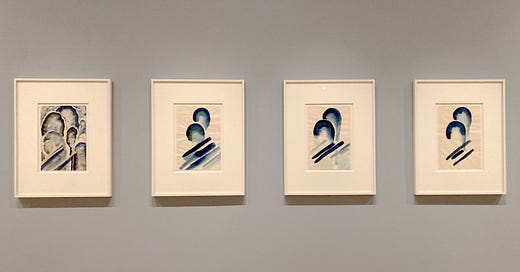While I was waiting for copyedits on First Love, preparing to dive into the final round of revisions, I went to a Georgia O’Keeffe exhibit at MoMA. Her famous flowers, lush and erotic, were delightful to see in person as always. But what captivated me most was a series of four watercolors, showing the same abstract blue shapes getting increasingly sparse in each successive iteration. The placard next to the series described the progression as “a process of compositional reduction.”
I remembered the series of Hopper sketches that had so moved me the previous year, and was struck by the way this series moved in the opposite direction: Where he built up more detail as the series progressed, she stripped it away. The word that echoed in my mind as I looked at these watercolors was “refinement.” The final piece was so satisfying—it felt clean, sure of itself.
“This,” I thought. “This is what I need to do to my sentences.”
If Hopper’s Nighthawk sketches had given me a way to think about drafting—building an essay in layers from the most general shapes to the finest details—O’Keeffe’s watercolor series was giving me a perfect demonstration of revision. Once it’s all on the page, pare back to just what’s essential. I wanted my essays to have the same feeling of precision and lightness as Blue #4.
When I’m drafting, I mix metaphors and over-describe, throwing everything I can think of into the mix. In my first attempt to describe these watercolors in the opening paragraph above, I wrote that the abstract blue shapes get increasingly “spare, precise, and refined” in each successive iteration. Reaching for the right adjective, I grabbed a handful and kept it moving so I wouldn’t lose my train of thought. Only after I’d gotten the gist of what I wanted to say sketched out could I take the time to sit with that sentence for a moment and decide that “sparse” would do the trick on its own. This last finicky stage is my favorite part. The part that the little girl version of me who kept a list of favorite new vocabulary words in her diary imagined when she said she wanted to be a writer.
This stage can also be extremely difficult. Switching from the big picture of what an essay is trying to say to the minute, nit-picky details of how to say it can create a kind of mental whiplash. First drafts are chaotic and uncertain, an exercise in trust that the road will appear beneath my feet as I run into empty space, never stopping to look back. The middle stages of revision are painstaking, sorting through my own early drafts as if through the incoherent ramblings of a mad stranger. After all of that, I have to recalibrate my mind when it’s time for the refining stage—otherwise it strains against such detailed work, skips over the placeholder words littering the draft because they’ve become familiar over the last several passes. Because that’s the tricky part: you have to read the work closer than ever right at the point when you never want to look at it again.
I was preparing for this recalibration when I encountered this O’Keeffe series—the visit to the museum an essential part of process. And now I had found a visual cue, a perfect depiction of the mental state I needed to reach in order to move through my manuscript word-by-word, rather than gulping down whole paragraphs or sections. I stood in front of these four watercolors for a long time, letting the shapes imprint themselves in me, feeling the flow of “compositional reduction” settle into my synapses. If I could make my mind as clear and precise as Blue #4, maybe the sentences would follow.






"...sorting through my own early drafts as if through the incoherent ramblings of a mad stranger" - same! Thank you for sharing yourself here. I'm also inspired by O'Keeffe's art and process and bravery.
Wonderful explanation. I am in that close revising stage of my memoir chapters now, and it is true that I feel I never want to look at them again--but I also know I am doing good work, honing in and making this thing the best it can be.